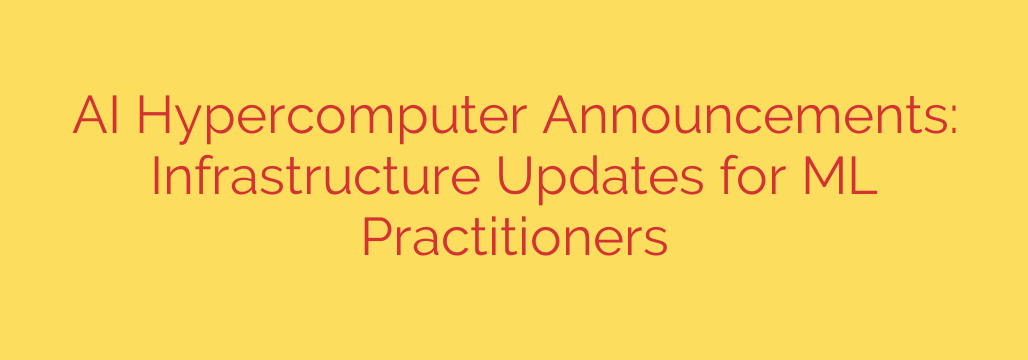
Powering the Future of AI: A Deep Dive into the Latest Hypercomputer Innovations
The world of artificial intelligence is moving at a blistering pace, with models growing larger and more complex by the day. To keep up, the hardware and infrastructure that power these models must evolve just as quickly. We are now firmly in the era of the AI hypercomputer—a class of purpose-built systems designed to handle the most demanding machine learning workloads on the planet.
Recent announcements in this space are not just incremental updates; they represent a fundamental shift in how we approach AI model development. For ML practitioners, data scientists, and engineers, understanding these changes is crucial for staying at the cutting edge.
What Exactly Is an AI Hypercomputer?
Think beyond a server rack filled with powerful GPUs. An AI hypercomputer is a tightly integrated, full-stack solution where every component—from the processors to the networking to the software—is co-engineered for one specific purpose: training and deploying massive AI models.
These systems are defined by a few key characteristics:
- Massive Scale: They often consist of thousands or even tens of thousands of interconnected GPUs or custom AI accelerators working in concert.
- High-Bandwidth, Low-Latency Networking: The performance of a hypercomputer is often limited by its ability to move data between chips. These systems use specialized, ultra-fast networking fabrics to ensure processors aren’t sitting idle waiting for data.
- Optimized Software Stack: The hardware is only half the battle. AI hypercomputers rely on a sophisticated software layer, including custom compilers, libraries, and orchestration tools, to make the immense power accessible to developers.
In essence, these are not just computers; they are AI factories, designed for peak efficiency and unprecedented scale.
Key Breakthroughs in Modern AI Infrastructure
The latest advancements are pushing the boundaries of what’s possible. Here are the core pillars of these new infrastructure updates.
1. Unprecedented Computational Density and Power
The raw horsepower of individual AI chips continues to soar. However, the real breakthrough is the ability to efficiently link them together. The new standard is building systems that can seamlessly scale to clusters of over 30,000 GPUs, allowing them to function as a single, colossal computational unit. This leap enables the training of next-generation foundation models with trillions of parameters—a task that was computationally prohibitive just a year ago.
2. The Network Is the New Bottleneck—And It’s Being Solved
As models are split across thousands of chips, the network connecting them becomes paramount. A slow network means expensive processors are wasted. The latest hypercomputer architectures feature extremely high-bandwidth internal networking, delivering multiple terabits per second of throughput to each processor. This ensures that the complex communication patterns required for techniques like model and pipeline parallelism can run without bottlenecks, dramatically accelerating training time.
3. A Full-Stack, System-Level Approach
Modern AI infrastructure is no longer just a collection of hardware. The most significant trend is the move towards fully integrated, purpose-built systems. This means the hardware, networking, storage, and software are designed and optimized together. For practitioners, this translates to a more stable, predictable, and performant environment. You spend less time wrestling with infrastructure and more time focusing on model architecture and innovation.
What These Advancements Mean for ML Practitioners
So, what does this all mean for those of you working in the trenches of machine learning? The implications are profound and direct.
- Drastically Reduced Training Times: Models that once took months to train can now be completed in weeks or even days. This rapid iteration cycle allows for more experimentation, faster innovation, and a quicker path from research to production.
- The Ability to Build Larger, More Sophisticated Models: Many novel AI architectures have been limited by available compute. With this new level of power, researchers and developers can unlock new frontiers in AI research, exploring more complex and capable models that were previously out of reach.
- Improved Cost-Efficiency for Large-Scale Projects: While the sticker price of a hypercomputer is astronomical, the performance-per-dollar and performance-per-watt are significantly improved. For organizations training foundation models, this improved efficiency at scale can lead to a lower total cost of ownership.
Actionable Security and Operational Tips
As you begin to leverage this next-generation infrastructure, typically through cloud service providers, it’s vital to adopt best practices.
- Prioritize Secure Access: When dealing with computational resources of this value, access controls are critical. Implement multi-factor authentication (MFA), principle of least privilege, and network segmentation to ensure only authorized personnel and processes can access the compute clusters.
- Master Parallelism Techniques: To effectively use a hypercomputer, you must understand how to parallelize your workload. Invest time in learning and implementing data parallelism, tensor parallelism, and pipeline parallelism using frameworks like PyTorch FSDP, JAX, or DeepSpeed.
- Focus on Software and Environment Management: The software stack (drivers, libraries like CUDA, communication libraries) is complex and fast-moving. Use containerization (like Docker or Singularity) to create reproducible environments and stay current with the latest optimized software releases from your cloud provider to ensure you’re getting maximum performance.
The era of AI hypercomputing is here. By understanding the core principles behind these powerful systems and adopting the right strategies, machine learning practitioners can harness this unprecedented power to build the next generation of artificial intelligence.
Source: https://cloud.google.com/blog/products/ai-machine-learning/q2-2025-ai-hypercomputer-updates/








